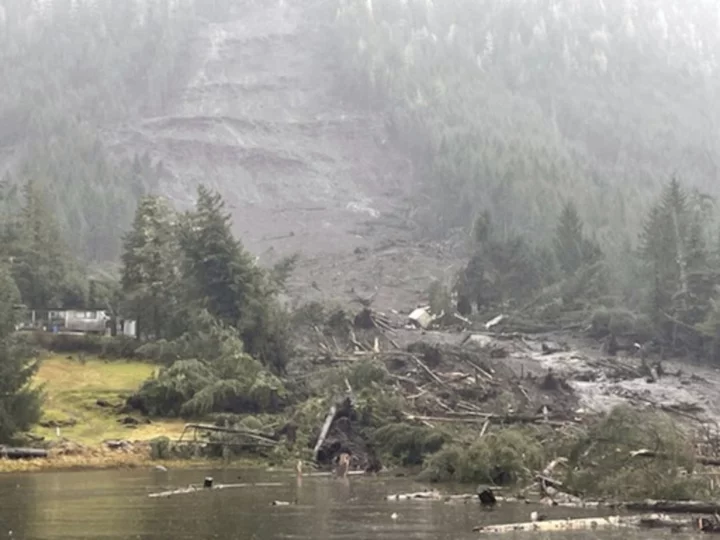JUNEAU, Alaska (AP) — Searchers with heat-sensing drones and a cadaver-dog kept up the search Wednesday for three people missing in a landslide that barreled down a mountain and slammed into homes in a remote Alaska fishing community, leaving three confirmed dead.
Monday night's slide churned up the earth from near the top of the mountain down to the sea, tearing down a wide swath of evergreen trees and burying a highway in the island community of Wrangell during a storm.
Rescue crews found the body of a girl in an initial search Monday night and the bodies of two adults late Tuesday in the island community, located about 155 miles (250 kilometers) south of Juneau.
Searchers again Wednesday were using a trained dog and heat-sensing drones to search for two children and one adult still unaccounted for. The Coast Guard and other vessels were scouring the waterfront littered with rocks, trees and mud from the slide.
Community residents wishing to help the search were welcomed Wednesday. “There is always a need for volunteer support when responding to a disaster,” Alaska State Troopers spokesperson Austin McDaniel said in an email to The Associated Press.
They could assist with checking in trained responders, updating maps, staffing command centers and other duties that would not put untrained people in danger, he said. Plus, it gives those wishing to help an avenue rather than going to the landslide and searching without first registering.
“Alaska has the highest per capita rate of veterans in the nation, and in times of disaster we have seen veterans that have highly specialized military training and assistance reach out to assist,” McDaniel said.
A woman who had been on the upper floor of a home was rescued Tuesday. She was in good condition and receiving medical care. One of the three homes that was struck was unoccupied, McDaniel said.
Wrangell interim borough manager Mason Villarma told The Associated Press in a phone interview the community was coming together amid the disaster.
"We’re broken, but resilient and determined to find everybody that’s missing,” Villarma said
Gov. Mike Dunleavy issued a disaster declaration for Wrangell and promised state resources for the community to recover.
Because of the hazards of searching an unstable area, a geologist from the state transportation department traveled from Juneau to conduct a preliminary assessment, clearing some areas of the debris field for ground searches. And troopers warned of the threat of additional landslides.
The slide — estimated to be 450 feet (137 meters) wide — occurred during a major rain and windstorm. Wrangell received about 2 inches (5 centimeters) of rain for several hours Monday afternoon and evening, with wind gusts up to 60 mph (96 kph) at higher elevations, said Aaron Jacobs, a National Weather Service hydrologist and meteorologist in Juneau.
It was part of a strong storm system that moved through southeast Alaska, bringing heavy snow in places and blizzard-like conditions to Juneau as well as rainfall with minor flooding further south.
Jacos said the rainfall Wrangell received on Monday wasn't unusual, but the strong winds could have helped trigger the slide.
Saturated soil can give way when gusts blow trees on a slope, said Barrett Salisbury, a geologist with the Alaska Department of Natural Resources.
Wrangell is one of the oldest non-Alaska Native settlements in the state, founded in 1811 when Russians began trading with Tlingits, according to a state database of Alaska communities. Indigenous people long lived in the area before outside contact. Tlingits, Russians, the British and Americans all accounted for historical influences on Wrangell.
Timber once was a major economic driver, but that has shifted to commercial fishing. Among its famous residents were Old West lawman Wyatt Earp, who served as temporary marshal for 10 days while he traveled to the Klondike, and naturist John Muir.
In December 2020, torrential rains prompted a landslide in another southeast Alaska city, claiming two lives. The slide slammed into a neighborhood in the community of Haines, leaving about 9 feet (2.7 meters) of mud and trees on city streets.
___
Thiessen reported from Anchorage, Alaska.

